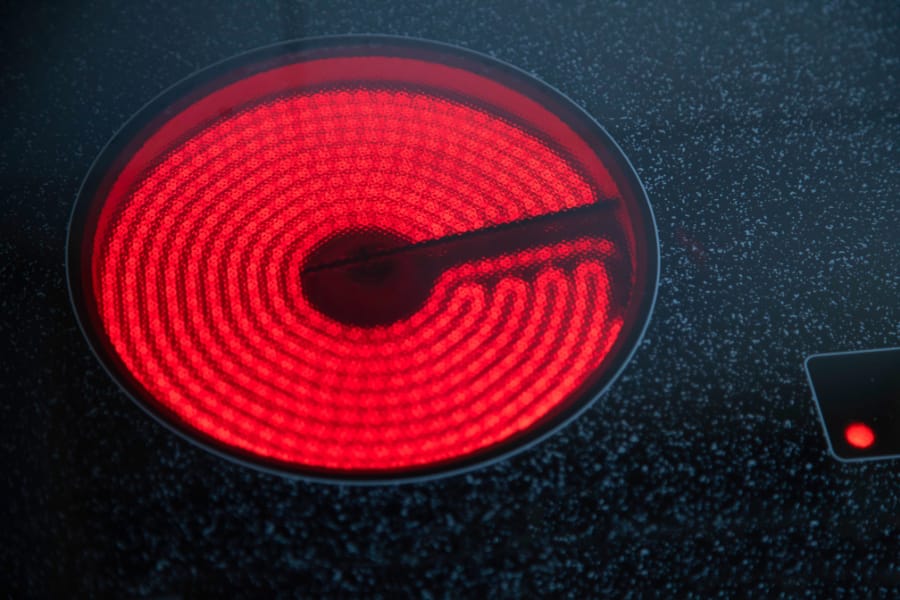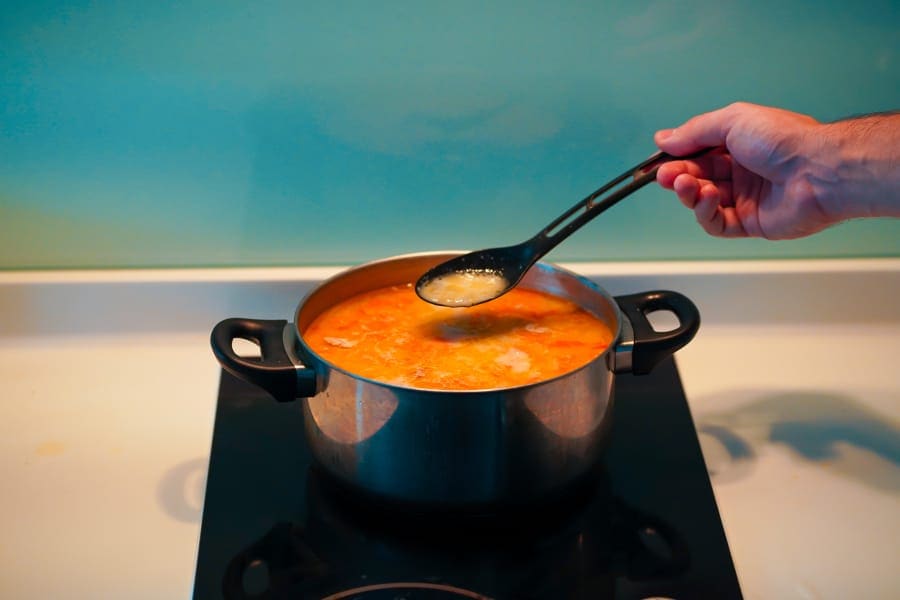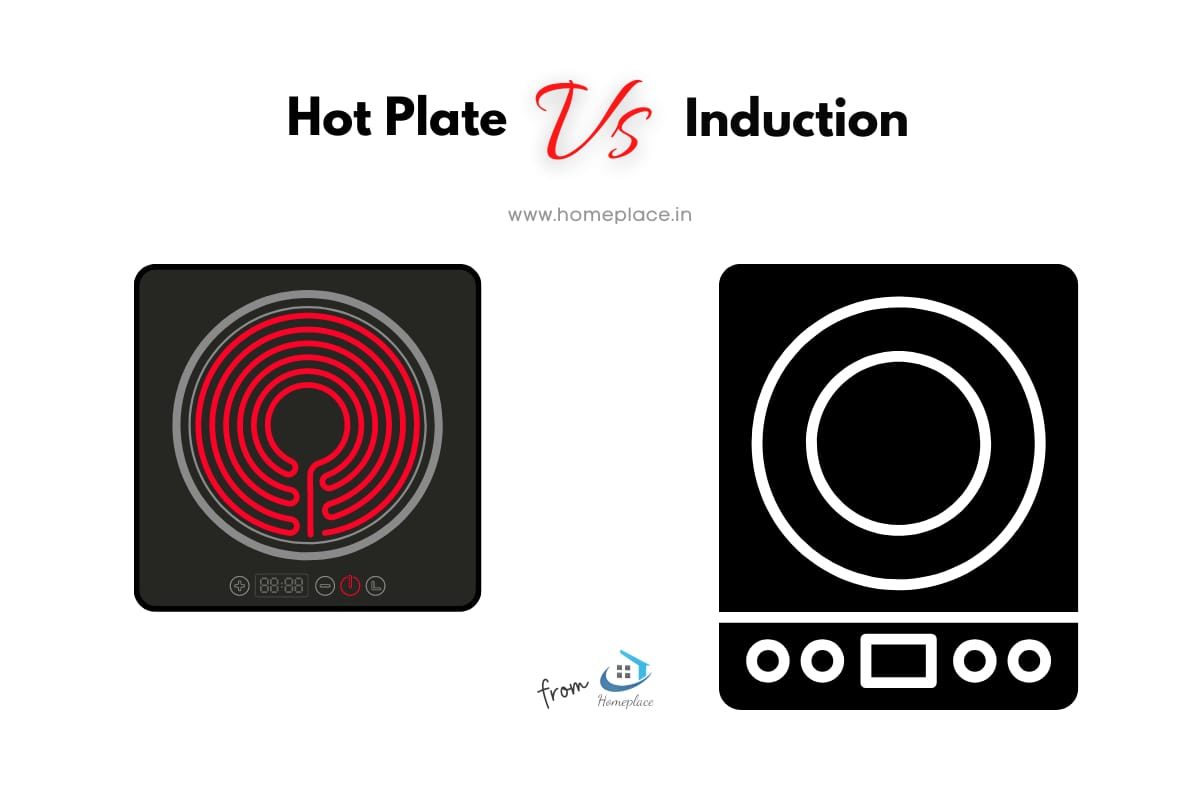The new era of cooking has come with a lot of advancement. The technology has also evolved to a stage where people can now use induction cooktops and hot plate stoves for cooking food instead of old traditional methods.
While they both are portable and electrically operated, some advantages and disadvantages make them unique for different purposes and requirements. By comparing a hot plate stove vs. an induction cooktop, you will find out which one would be ideal for you.
What is a hot Plate Stove?

A hot plate stove is a type of kitchen appliance that uses a metal plate heated by an electrical coil to cook food. The technicalities of a hot plate stove are pretty simple. Newer models are equipped with a halogen heating feature, which heats up much faster than the traditional ones.
Many hot plate stoves are provided with one or two burners with several knobs for temperature control. It acts as a replacement for a traditional oven or another heating source in your kitchen. Hot plate stoves come in many designs and sizes, with the smaller ones being portable.
Advantages of Hot Plate Stove
1. Compact Design of hot plate stove
Space is always an issue in the kitchen, and the hot plate stove is small and compact, taking up minimal counter space. Hot plate stoves are also lighter than other types of cooktops, making them easier to move around. It is ideal for small apartments or college dorms where space is limited.
2. Versatile in Nature
The hot plate stove can be used for various purposes, from making a single serving of cereal in the morning to heating up a large meal. It is certainly a versatile choice.
3. Quick and Even Heat Distribution
Hot plate stoves help in the quick and even cooking of food. The heat transfer is uniform, and therefore there is no hot or cold section. This is great for cooking and reheating small batches of food.
4. Hot plate stoves are affordable
The main advantage of a hot plate stove over an induction cooktop is cost. Because hot plate stoves are smaller and have simpler technology, the unit itself is cheaper. The cost is usually about half that of induction cooktops of similar capacity.
5. Compatible with any metallic cookware
As the heat is transferred directly to the bottom of the pan, any metal cookware can be used while cooking on a hot plate stove.
Disadvantages of Hot Plate Stove
1. less Durable and safe than an induction cooktop
Unlike an induction cooktop, a hot plate stove heats up the cooking surface (plate). For this reason, you must handle it with care. Also, the increased temperature is distributed all over the machine’s body, making it prone to wear and tear over time.
2. Hot plate stove creates noise
The biggest downside to hot plate stoves is that they can be loud, whereas, the noise generated by an induction cooktop is minimal. It can be a problem in the kitchen, especially if you live in a small apartment.
3. Challenging to clean and maintain
The spilling of liquid food ingredients is evident in every kitchen. As the hot plate surface is heated, you cannot clean any spillage immediately, and you have to wait till the plate cools down. In the meantime, the food burns, making dark patches challenging to clean.
Ideal Uses of hot plate stove
Hot plate stoves are usually more compact than induction stoves, making them ideal for use in small spaces. A hot plate stove is an excellent choice for those who prefer the convenience of an induction cooktop without the high cost.
They are perfect for cooking and reheating food that requires low heat for prolonged periods. Hot plate stoves tend to heat evenly, making them suitable for single servings.
What is an induction Cooktop?

An induction cooktop is a kitchen appliance that cooks food utilizing heat generated by a magnetic field following the principle of electromagnetic induction.
The induction coil comprises several small loops of copper wires connected and wrapped around a non-magnetic material such as aluminum or heat-resistant plastic.
An induction cooktop is available in various designs – flat or stand-up, but most of their characteristics are the same. The most common models of induction cooktops are single elements and double elements.
Advantages of Induction Cooktop
1. Cooks Food Faster and Efficiently
One of the most significant advantages of using an induction cooktop is the fact that it heats up faster than hot plate stoves. This allows you to use the induction cooktop for cooking a large amount of food within a short time.
The best induction cooktop has precise temperature control. You can cook food accurately which is never possible on a hot plate. It also maintains a consistent temperature throughout the cooking process.
2. Attractive design & versatile
Induction cooktops have an ergonomic exterior and have vents to recirculate air. The stovetop is made of heat-resistant ceramic or tempered glass that looks fantastic and safe. Modern induction cooktops come with touch or gesture control to adjust the temperature, timer, or menu. On the other hand, hot plate stoves do not have such advanced options.
An induction cooktop can be a fine addition if you have a modular kitchen. It is more versatile and durable in comparison to hot plate stoves. You can use it to cook, fry, boil, or reheat your food.
4. Induction cooktops make less noise
A buzzing or humming sound is often heard while operating an induction cooktop. The noise is caused by an electromagnetic field required to induce heat on the cookware. However, this noise is as low as compared to the noise made by a hot plate stove.
5. Easy to Clean and Maintain
The surface of an induction cooktop remains cool even after cooking. Therefore, it is effortless to clean as the food doesn’t burn and can be removed with a single wipe with a wet cloth. They are easy to clean, with almost zero maintenance.
Disadvantages of an Induction Cooktop
1. Expensive
The cost of an induction cooktop is usually higher than a hot plate stove since it is a more advanced kitchen appliance with modern technologies. Hence, it is not a budget-friendly option than a hot plate stove.
2. Specific cookware requirement
Induction cooktops require unique types of cookware, which is more expensive than usual cooking pans. You can use flat-bottom cookware with ferromagnetic material (iron) on them.
Ideal Uses induction cooktop
Being a versatile kitchen appliance, induction cooktops can cook multiple types of foods. Its ability to generate high temperatures of up to 300°C makes it ideal for a wide range of cooking methods and menus, including baking, frying, steaming, and simmering. Induction cooktops are ideal for those looking for a quiet, fast, and energy-efficient way of cooking.

Hot Plate Stove vs. Induction Cooktop comparison
| Point of Difference | Hot Plate Stove | Induction Cooktop |
|---|---|---|
| Working Method | A hot plate stove is less efficient for cooking than the induction stove. | An induction cooktop works on the principle of electromagnetic induction, which is generated by passing electricity through a coil. |
| Power Consumption | This type of stove consumes more energy than the induction cooktop. You can find most hot plate stoves consume 1000-2200 watts of power. | Induction cooktops use more energy than hot plate stoves. It consumes around 1000-2100 watts of energy for different outputs. |
| Applications | Hot plates have a limited range of applications as it is used to cook smaller amounts of food or make barbecue. | Induction has a wide range of applications. It is used to cook larger amounts of food and is used in frying, sautéing, boiling, etc. |
| Cookware Compatibility | It is compatible with all types of metal cookware. | An induction cooktop requires cookware that is compatible with ferromagnetic hobs for cooking food. |
| Cooking Efficiency | An induction cooktop has a touch/gesture/button control panel, which enables the user to adjust the temperature with 8-12 modes. | An induction cooktop is more efficient due to its design and latest technology. |
| Size and Dimension | In terms of dimensions, hot plate stoves are slightly smaller than induction cooktops. | It is slightly larger in size and also has a larger cooking area. |
| Weight | Hot plate stoves are heavier than induction cooktops. | It is a delicate appliance and is lighter in comparison. |
| Operating Panel | A hot plate stove has a touch/button control panel. It is used to control the temperature with 3-5 modes and turn the machine on or off. | Hot plates are more expensive than induction cooktops, especially infrared hot plate stoves. |
| Cleaning and Maintenance | This type of stove is quite hard to clean and maintain as it remains hot during cooking. | This cooktop is very easy to clean and maintain as heating occurs only on the cookware. |
| Safety | Due to the heating of the cooktop, hot plate stoves are a little unsafe to use. | Hot plates are more expensive than induction cooktops, especially the infrared hot plate stoves. |
| Affordability | An induction cooktop is a safer stove compared to a hot plate. | Though induction cooktops are more affordable than hot plate stoves. |
Induction Cooktop and Hot Plate Stove – The Differences
Working Method of Induction and hot plate stoves
Induction cookers and electric hot plate cooktops work differently. Hot plate cooks food on the principle of thermal radiation, i.e., heat transfer through the metal plate heated by a heating element installed inside. Modern infrared hot plates are more advanced and sophisticated.
On the other hand, in the case of induction cooktops, heating is done by inducing an electromagnetic field on the cookware by means of passing electricity through a copper or aluminum coil.
Induction cooktops are more energy efficient
Induction cooktops are more energy-efficient (90-95%) than hot plate stoves as the heat is generated only on the cookware and no energy is wasted. On the other hand, hot plate stoves take a long time to heat up, which loses the energy to the surroundings by means of radiation. Hence, induction cooktops are preferable to hot plate stoves.
Hot plate stoves are less versatile
Induction cooktops have their own applications and are used for different purposes. They are used for cooking at very high temperatures that are not as easily cooked on a hot plate.
An induction cooktop is suitable for regular cooking, boiling eggs, baking, frying, and sautéing compared to a hot plate stove that is best for steaming and reheating.
Cookware Compatibility of hot plate & induction
Cookware compatibility is a major consideration when choosing a stove. In this case, hot plate stoves outperform induction cooktops as they are compatible with all types of cookware material- stainless steel, copper, cast iron, hard anodized, ceramic, etc.
As an induction cooktop generates heat by means of electromagnetic radiation, it requires flat-bottom cookware made of iron. This is why aluminum, copper, and glass cookware cannot be used on induction cooktops.
Size, weight, and Dimension of the stoves
Both Induction cooktops and hot plate stoves are small in size. However, a hot plate is slightly smaller than the induction cooktop in dimensions (length and width). The size of a hot plate is small enough for a bachelor or a family of two, whereas an induction cooktop can be used for large families.
A hot plate is heavier than the induction cooktop, and it weighs about 3-5 Kg, whereas an induction cooktop usually weighs about 1-3 Kg.
Operating Panel & temperature control system
An induction cooktop contains a panel with power and temperature control buttons. It is integrated with touch and gesture sensors, along with a power button, a timer function, and an LED light display that shows the current status. Induction cooktops have a superior temperature control system than hot plate cookers. Usually, induction cooktops have 8-12 temperature options in the range of 100-300°C.
However, hot plate stoves only have three low, medium, and high-temperature settings. In some cases, five modes are also available.
Cleaning and Maintenance
If you are looking for an easy-to-clean electric stove, induction cooktops are definitely a better choice than hot plate stoves. As the heat is only induced on the magnetic cookware, it does not dissipate thermal energy on the cooktop body and in the kitchen environment. So, you can easily wipe off spillages with a wet cloth.
On the other hand, a hot plate is harder to clean as the metal plate remains heated during and after cooking. For this reason, an induction cooktop is undoubtedly preferable to a hot plate stove.
Induction vs. hot plate stove: Safety
Induction cooktops are safer to use than hot plate stoves as they do not have the danger of hot spots and are cool to touch. A cooking zone is a marked ring on the cooktop surface to indicate the heating area. Place your cookware inside this zone and cook for hours safely!
The hot plate mounted on the heating coil of hot plate stoves is always heated when turned on. Thus, you must not touch it to avoid injury.
Hot plate or induction cooktop – which is more affordable?
Hot plate stoves that work on the thermal radiation method, are cheaper in the price range of ₹1000 to ₹4000. However, infrared hot plates are more pricey than induction cooktops. Overall, inductions offer more value for the money you spend.
So, hot plate stove or induction cooktop – which is better?
From the above comparison with the pros and cons of hot plate stoves and induction cooktops, it is clear that both appliances are great to cook food. However, induction cooktops are better in design, versatile cooking, energy efficiency, and cost.
On the other hand, hot plates are the ideal option to cook on any type of cookware. Considering all of the advantages and disadvantages of both, induction cooktops are far better than hot plate stoves.
Depending on your own needs, requirements, aesthetics, and your kitchen space, you should choose between a hot plate stove and an induction cooktop.
Related Comparison:
